Airline Communication Strategies
VerifiedAdded on 2020/03/23
|10
|2881
|40
AI Summary
This assignment delves into the crucial role of communication within the airline industry. It requires a comprehensive analysis of various communication strategies employed by airlines, examining their influence on critical aspects such as flight safety, customer service satisfaction, and brand reputation. The task further challenges students to propose innovative and effective solutions for enhancing communication practices within the aviation sector.
Contribute Materials
Your contribution can guide someone’s learning journey. Share your
documents today.
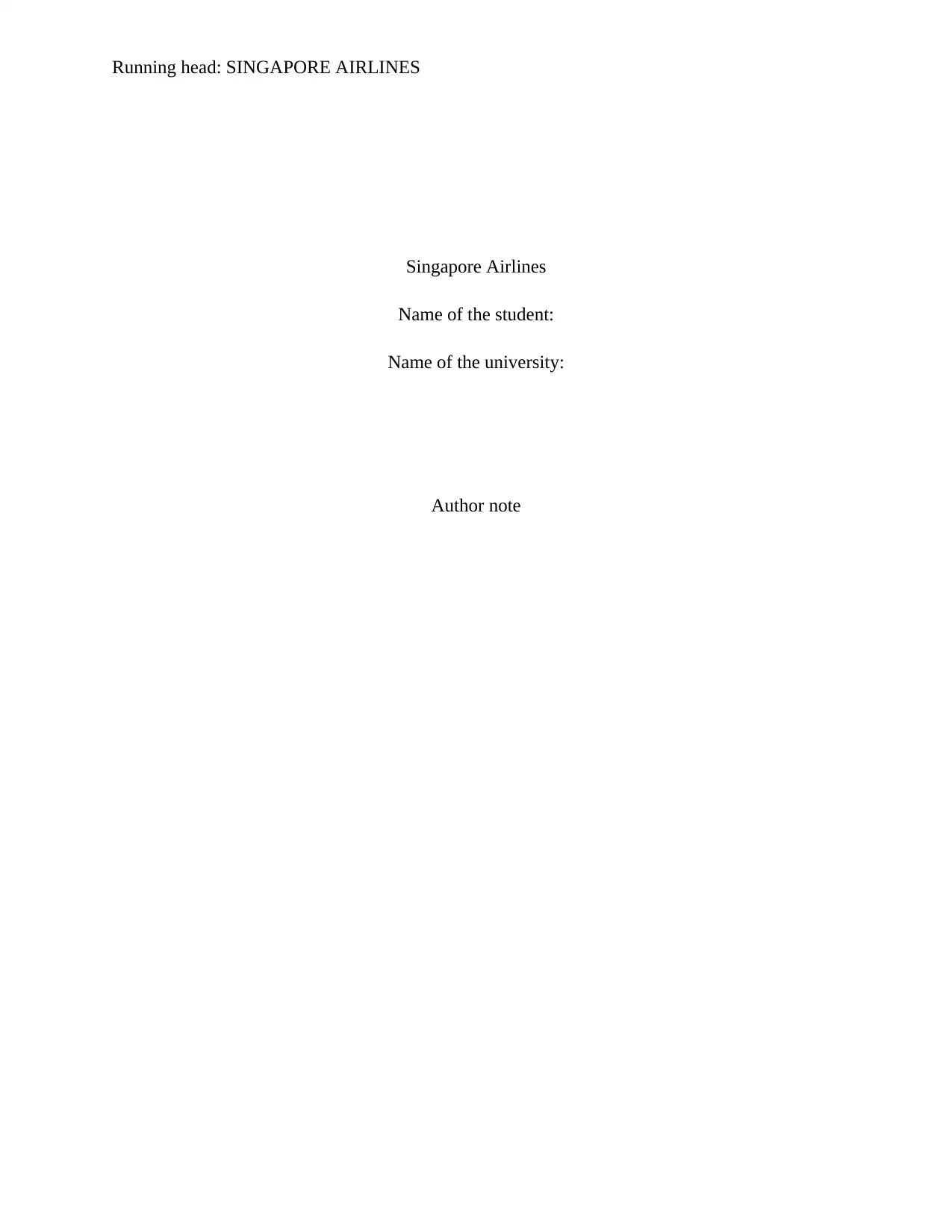
Running head: SINGAPORE AIRLINES
Singapore Airlines
Name of the student:
Name of the university:
Author note
Singapore Airlines
Name of the student:
Name of the university:
Author note
Secure Best Marks with AI Grader
Need help grading? Try our AI Grader for instant feedback on your assignments.
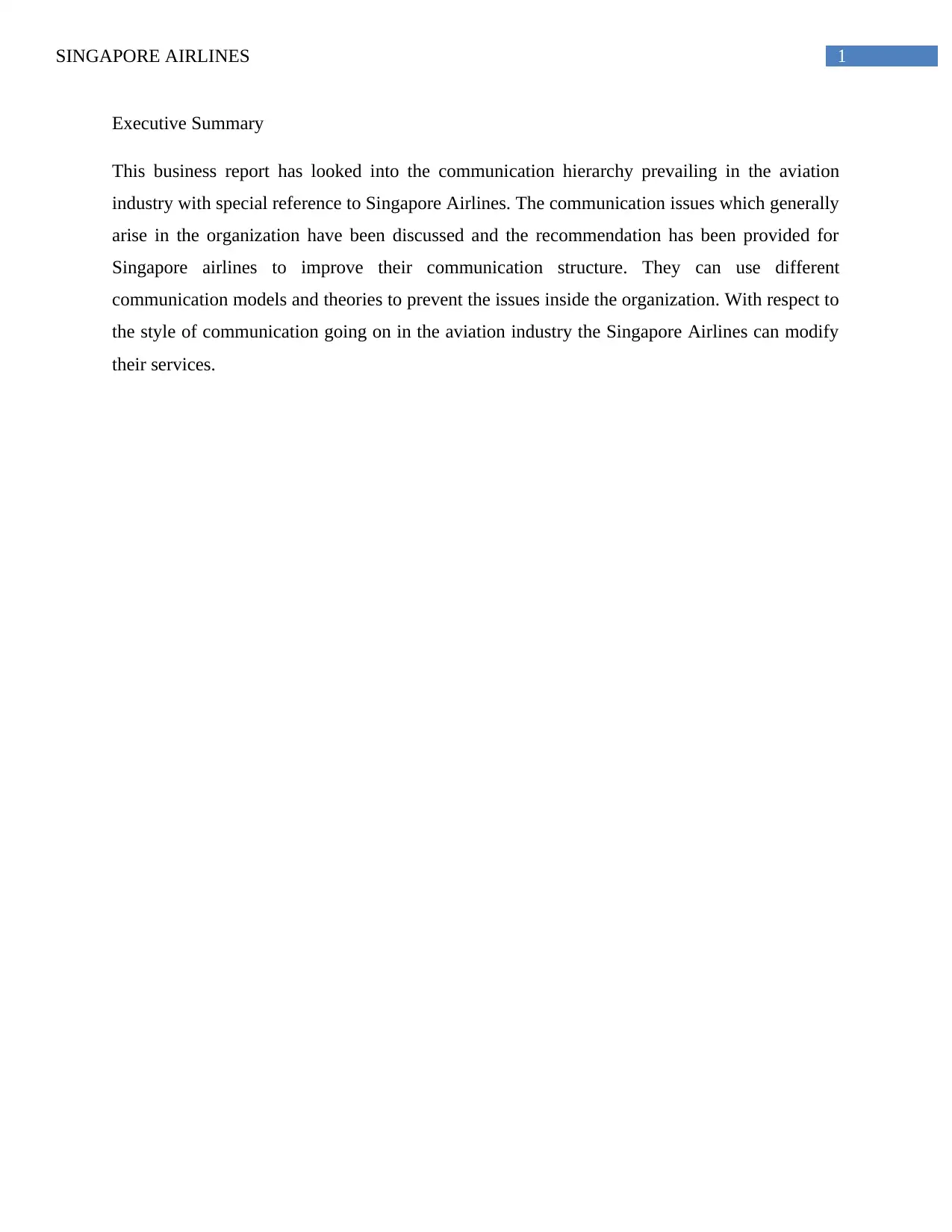
1SINGAPORE AIRLINES
Executive Summary
This business report has looked into the communication hierarchy prevailing in the aviation
industry with special reference to Singapore Airlines. The communication issues which generally
arise in the organization have been discussed and the recommendation has been provided for
Singapore airlines to improve their communication structure. They can use different
communication models and theories to prevent the issues inside the organization. With respect to
the style of communication going on in the aviation industry the Singapore Airlines can modify
their services.
Executive Summary
This business report has looked into the communication hierarchy prevailing in the aviation
industry with special reference to Singapore Airlines. The communication issues which generally
arise in the organization have been discussed and the recommendation has been provided for
Singapore airlines to improve their communication structure. They can use different
communication models and theories to prevent the issues inside the organization. With respect to
the style of communication going on in the aviation industry the Singapore Airlines can modify
their services.
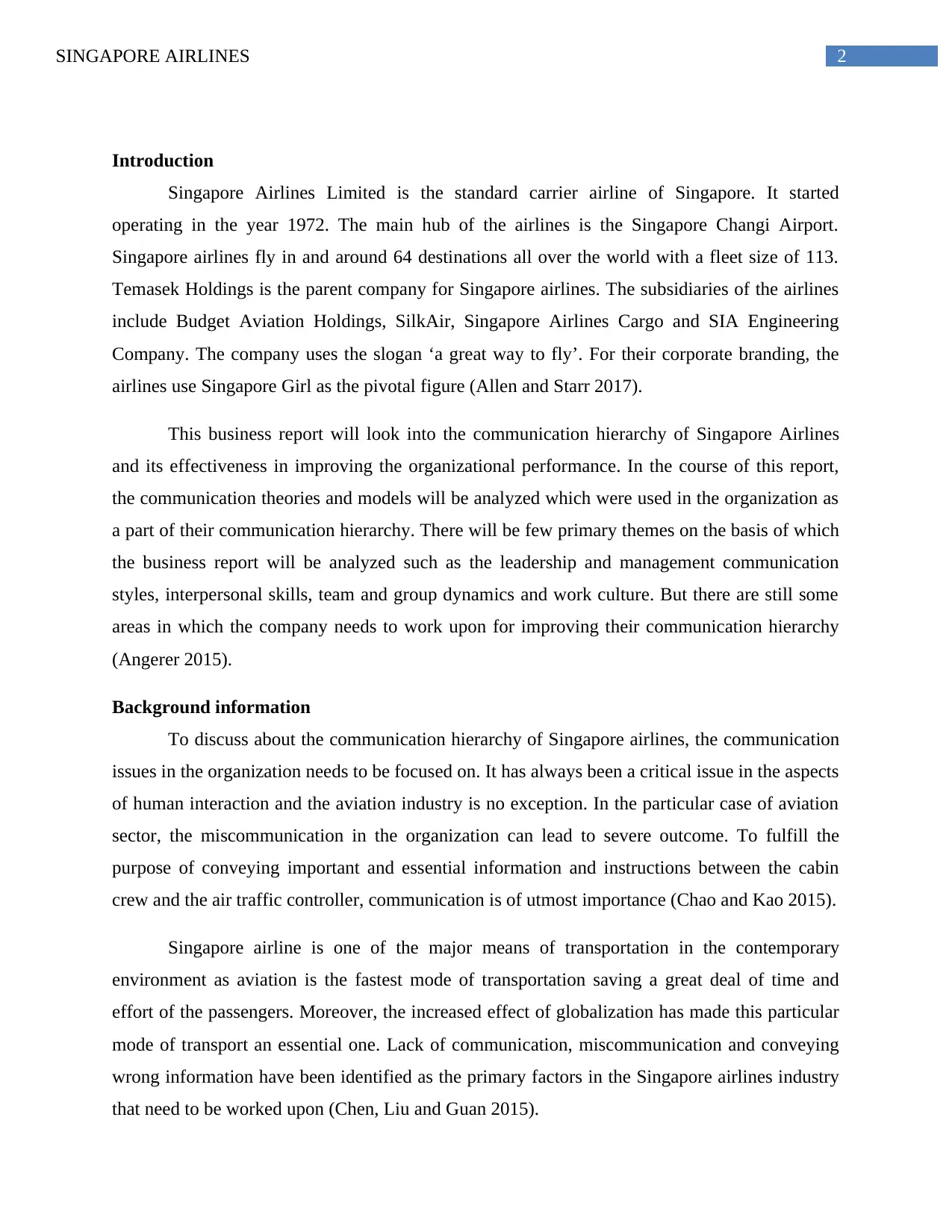
2SINGAPORE AIRLINES
Introduction
Singapore Airlines Limited is the standard carrier airline of Singapore. It started
operating in the year 1972. The main hub of the airlines is the Singapore Changi Airport.
Singapore airlines fly in and around 64 destinations all over the world with a fleet size of 113.
Temasek Holdings is the parent company for Singapore airlines. The subsidiaries of the airlines
include Budget Aviation Holdings, SilkAir, Singapore Airlines Cargo and SIA Engineering
Company. The company uses the slogan ‘a great way to fly’. For their corporate branding, the
airlines use Singapore Girl as the pivotal figure (Allen and Starr 2017).
This business report will look into the communication hierarchy of Singapore Airlines
and its effectiveness in improving the organizational performance. In the course of this report,
the communication theories and models will be analyzed which were used in the organization as
a part of their communication hierarchy. There will be few primary themes on the basis of which
the business report will be analyzed such as the leadership and management communication
styles, interpersonal skills, team and group dynamics and work culture. But there are still some
areas in which the company needs to work upon for improving their communication hierarchy
(Angerer 2015).
Background information
To discuss about the communication hierarchy of Singapore airlines, the communication
issues in the organization needs to be focused on. It has always been a critical issue in the aspects
of human interaction and the aviation industry is no exception. In the particular case of aviation
sector, the miscommunication in the organization can lead to severe outcome. To fulfill the
purpose of conveying important and essential information and instructions between the cabin
crew and the air traffic controller, communication is of utmost importance (Chao and Kao 2015).
Singapore airline is one of the major means of transportation in the contemporary
environment as aviation is the fastest mode of transportation saving a great deal of time and
effort of the passengers. Moreover, the increased effect of globalization has made this particular
mode of transport an essential one. Lack of communication, miscommunication and conveying
wrong information have been identified as the primary factors in the Singapore airlines industry
that need to be worked upon (Chen, Liu and Guan 2015).
Introduction
Singapore Airlines Limited is the standard carrier airline of Singapore. It started
operating in the year 1972. The main hub of the airlines is the Singapore Changi Airport.
Singapore airlines fly in and around 64 destinations all over the world with a fleet size of 113.
Temasek Holdings is the parent company for Singapore airlines. The subsidiaries of the airlines
include Budget Aviation Holdings, SilkAir, Singapore Airlines Cargo and SIA Engineering
Company. The company uses the slogan ‘a great way to fly’. For their corporate branding, the
airlines use Singapore Girl as the pivotal figure (Allen and Starr 2017).
This business report will look into the communication hierarchy of Singapore Airlines
and its effectiveness in improving the organizational performance. In the course of this report,
the communication theories and models will be analyzed which were used in the organization as
a part of their communication hierarchy. There will be few primary themes on the basis of which
the business report will be analyzed such as the leadership and management communication
styles, interpersonal skills, team and group dynamics and work culture. But there are still some
areas in which the company needs to work upon for improving their communication hierarchy
(Angerer 2015).
Background information
To discuss about the communication hierarchy of Singapore airlines, the communication
issues in the organization needs to be focused on. It has always been a critical issue in the aspects
of human interaction and the aviation industry is no exception. In the particular case of aviation
sector, the miscommunication in the organization can lead to severe outcome. To fulfill the
purpose of conveying important and essential information and instructions between the cabin
crew and the air traffic controller, communication is of utmost importance (Chao and Kao 2015).
Singapore airline is one of the major means of transportation in the contemporary
environment as aviation is the fastest mode of transportation saving a great deal of time and
effort of the passengers. Moreover, the increased effect of globalization has made this particular
mode of transport an essential one. Lack of communication, miscommunication and conveying
wrong information have been identified as the primary factors in the Singapore airlines industry
that need to be worked upon (Chen, Liu and Guan 2015).
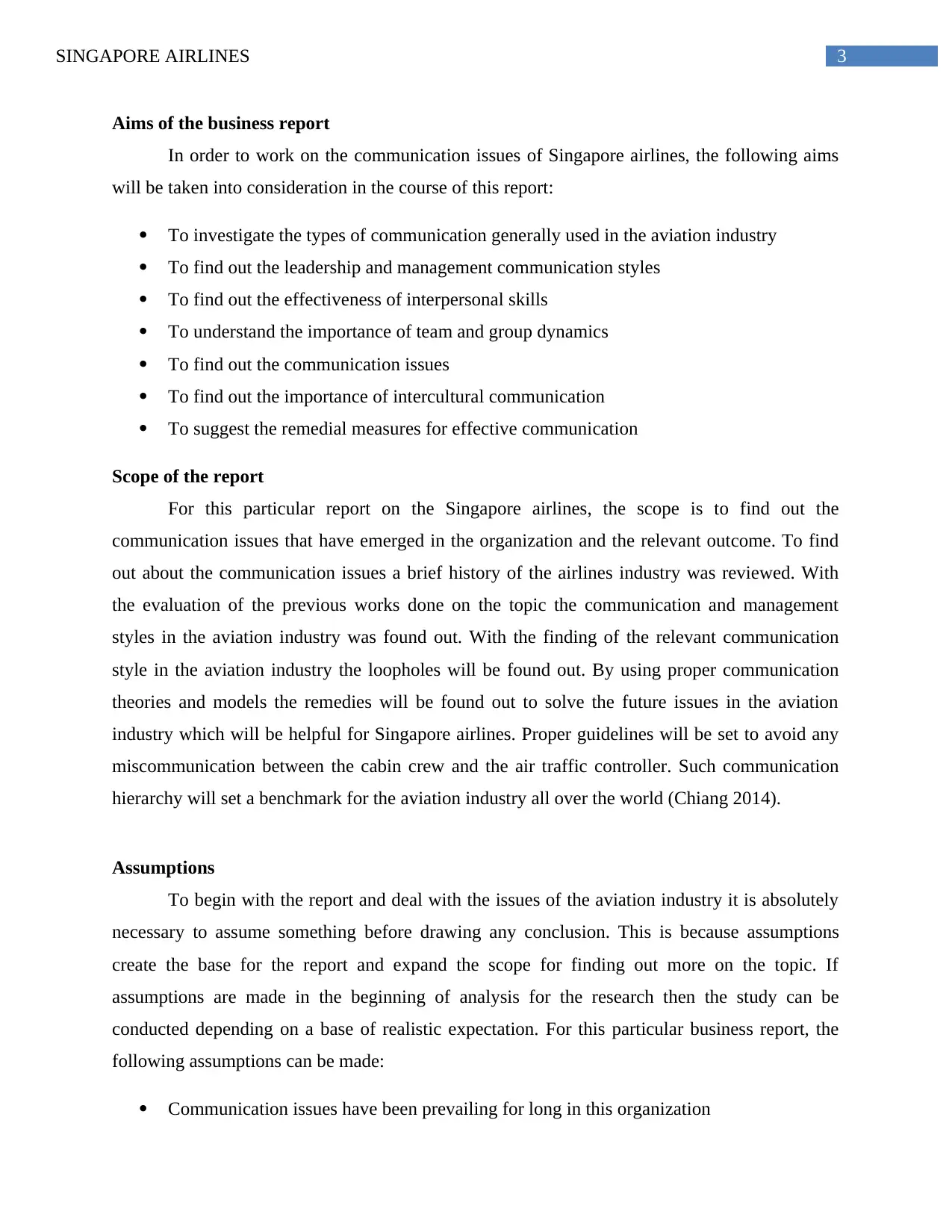
3SINGAPORE AIRLINES
Aims of the business report
In order to work on the communication issues of Singapore airlines, the following aims
will be taken into consideration in the course of this report:
To investigate the types of communication generally used in the aviation industry
To find out the leadership and management communication styles
To find out the effectiveness of interpersonal skills
To understand the importance of team and group dynamics
To find out the communication issues
To find out the importance of intercultural communication
To suggest the remedial measures for effective communication
Scope of the report
For this particular report on the Singapore airlines, the scope is to find out the
communication issues that have emerged in the organization and the relevant outcome. To find
out about the communication issues a brief history of the airlines industry was reviewed. With
the evaluation of the previous works done on the topic the communication and management
styles in the aviation industry was found out. With the finding of the relevant communication
style in the aviation industry the loopholes will be found out. By using proper communication
theories and models the remedies will be found out to solve the future issues in the aviation
industry which will be helpful for Singapore airlines. Proper guidelines will be set to avoid any
miscommunication between the cabin crew and the air traffic controller. Such communication
hierarchy will set a benchmark for the aviation industry all over the world (Chiang 2014).
Assumptions
To begin with the report and deal with the issues of the aviation industry it is absolutely
necessary to assume something before drawing any conclusion. This is because assumptions
create the base for the report and expand the scope for finding out more on the topic. If
assumptions are made in the beginning of analysis for the research then the study can be
conducted depending on a base of realistic expectation. For this particular business report, the
following assumptions can be made:
Communication issues have been prevailing for long in this organization
Aims of the business report
In order to work on the communication issues of Singapore airlines, the following aims
will be taken into consideration in the course of this report:
To investigate the types of communication generally used in the aviation industry
To find out the leadership and management communication styles
To find out the effectiveness of interpersonal skills
To understand the importance of team and group dynamics
To find out the communication issues
To find out the importance of intercultural communication
To suggest the remedial measures for effective communication
Scope of the report
For this particular report on the Singapore airlines, the scope is to find out the
communication issues that have emerged in the organization and the relevant outcome. To find
out about the communication issues a brief history of the airlines industry was reviewed. With
the evaluation of the previous works done on the topic the communication and management
styles in the aviation industry was found out. With the finding of the relevant communication
style in the aviation industry the loopholes will be found out. By using proper communication
theories and models the remedies will be found out to solve the future issues in the aviation
industry which will be helpful for Singapore airlines. Proper guidelines will be set to avoid any
miscommunication between the cabin crew and the air traffic controller. Such communication
hierarchy will set a benchmark for the aviation industry all over the world (Chiang 2014).
Assumptions
To begin with the report and deal with the issues of the aviation industry it is absolutely
necessary to assume something before drawing any conclusion. This is because assumptions
create the base for the report and expand the scope for finding out more on the topic. If
assumptions are made in the beginning of analysis for the research then the study can be
conducted depending on a base of realistic expectation. For this particular business report, the
following assumptions can be made:
Communication issues have been prevailing for long in this organization
Secure Best Marks with AI Grader
Need help grading? Try our AI Grader for instant feedback on your assignments.
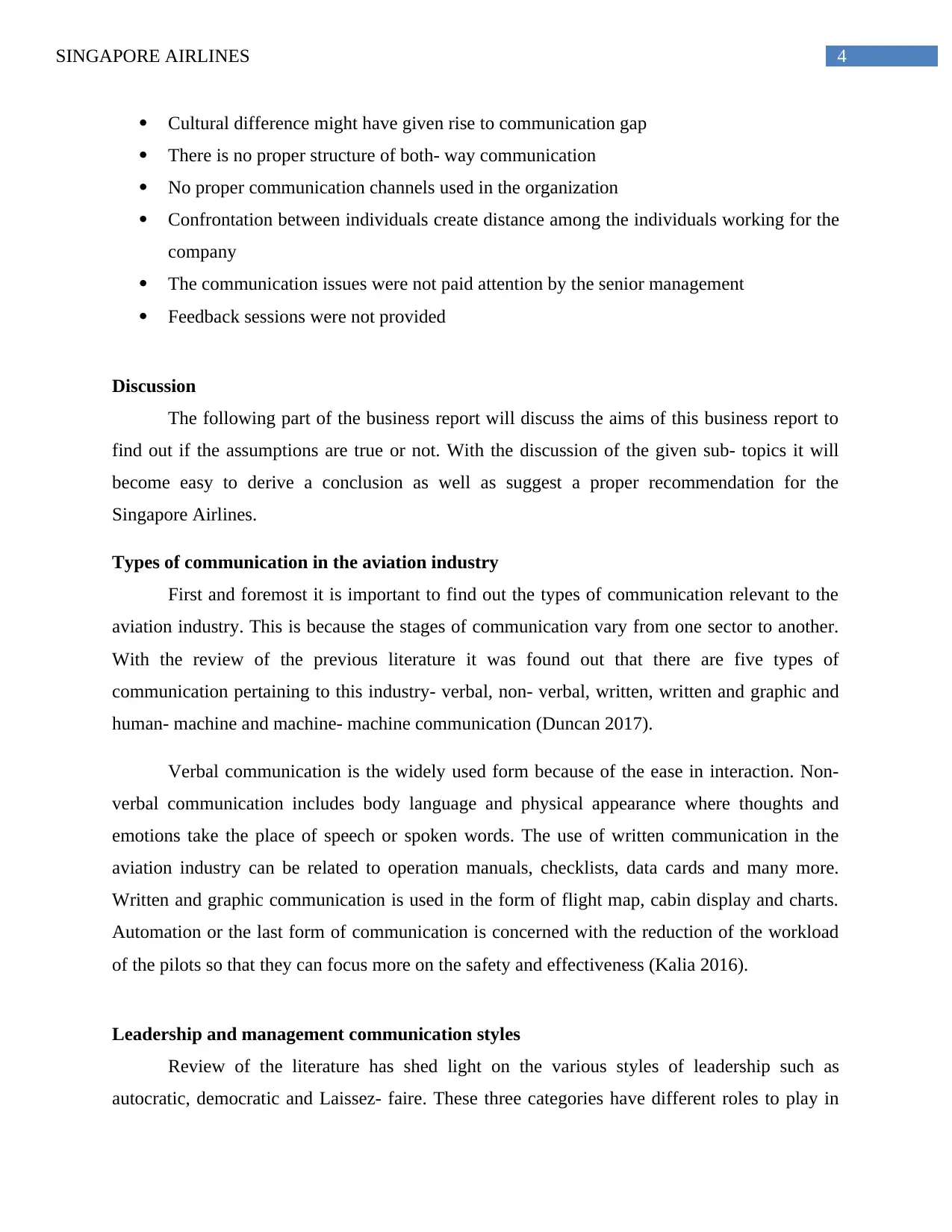
4SINGAPORE AIRLINES
Cultural difference might have given rise to communication gap
There is no proper structure of both- way communication
No proper communication channels used in the organization
Confrontation between individuals create distance among the individuals working for the
company
The communication issues were not paid attention by the senior management
Feedback sessions were not provided
Discussion
The following part of the business report will discuss the aims of this business report to
find out if the assumptions are true or not. With the discussion of the given sub- topics it will
become easy to derive a conclusion as well as suggest a proper recommendation for the
Singapore Airlines.
Types of communication in the aviation industry
First and foremost it is important to find out the types of communication relevant to the
aviation industry. This is because the stages of communication vary from one sector to another.
With the review of the previous literature it was found out that there are five types of
communication pertaining to this industry- verbal, non- verbal, written, written and graphic and
human- machine and machine- machine communication (Duncan 2017).
Verbal communication is the widely used form because of the ease in interaction. Non-
verbal communication includes body language and physical appearance where thoughts and
emotions take the place of speech or spoken words. The use of written communication in the
aviation industry can be related to operation manuals, checklists, data cards and many more.
Written and graphic communication is used in the form of flight map, cabin display and charts.
Automation or the last form of communication is concerned with the reduction of the workload
of the pilots so that they can focus more on the safety and effectiveness (Kalia 2016).
Leadership and management communication styles
Review of the literature has shed light on the various styles of leadership such as
autocratic, democratic and Laissez- faire. These three categories have different roles to play in
Cultural difference might have given rise to communication gap
There is no proper structure of both- way communication
No proper communication channels used in the organization
Confrontation between individuals create distance among the individuals working for the
company
The communication issues were not paid attention by the senior management
Feedback sessions were not provided
Discussion
The following part of the business report will discuss the aims of this business report to
find out if the assumptions are true or not. With the discussion of the given sub- topics it will
become easy to derive a conclusion as well as suggest a proper recommendation for the
Singapore Airlines.
Types of communication in the aviation industry
First and foremost it is important to find out the types of communication relevant to the
aviation industry. This is because the stages of communication vary from one sector to another.
With the review of the previous literature it was found out that there are five types of
communication pertaining to this industry- verbal, non- verbal, written, written and graphic and
human- machine and machine- machine communication (Duncan 2017).
Verbal communication is the widely used form because of the ease in interaction. Non-
verbal communication includes body language and physical appearance where thoughts and
emotions take the place of speech or spoken words. The use of written communication in the
aviation industry can be related to operation manuals, checklists, data cards and many more.
Written and graphic communication is used in the form of flight map, cabin display and charts.
Automation or the last form of communication is concerned with the reduction of the workload
of the pilots so that they can focus more on the safety and effectiveness (Kalia 2016).
Leadership and management communication styles
Review of the literature has shed light on the various styles of leadership such as
autocratic, democratic and Laissez- faire. These three categories have different roles to play in
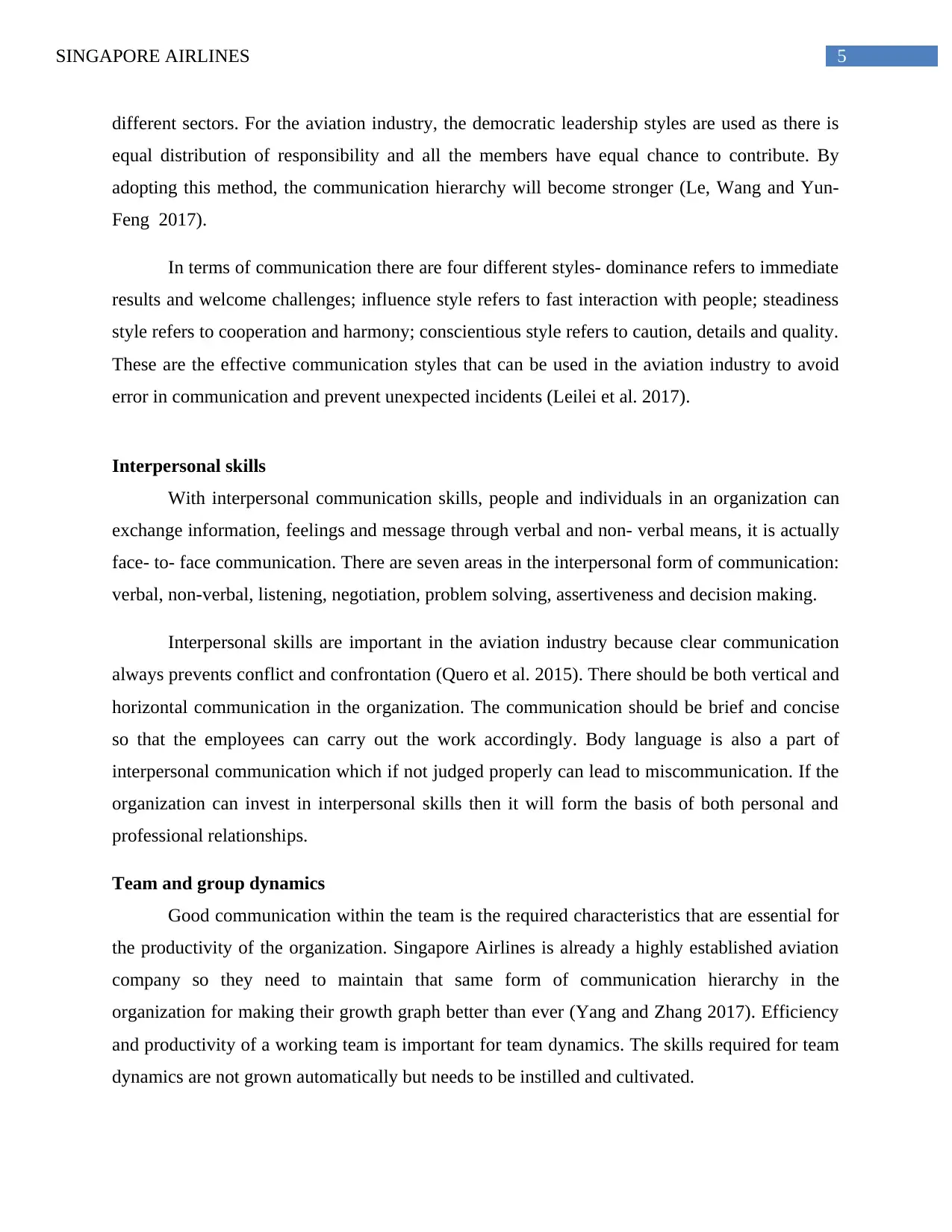
5SINGAPORE AIRLINES
different sectors. For the aviation industry, the democratic leadership styles are used as there is
equal distribution of responsibility and all the members have equal chance to contribute. By
adopting this method, the communication hierarchy will become stronger (Le, Wang and Yun-
Feng 2017).
In terms of communication there are four different styles- dominance refers to immediate
results and welcome challenges; influence style refers to fast interaction with people; steadiness
style refers to cooperation and harmony; conscientious style refers to caution, details and quality.
These are the effective communication styles that can be used in the aviation industry to avoid
error in communication and prevent unexpected incidents (Leilei et al. 2017).
Interpersonal skills
With interpersonal communication skills, people and individuals in an organization can
exchange information, feelings and message through verbal and non- verbal means, it is actually
face- to- face communication. There are seven areas in the interpersonal form of communication:
verbal, non-verbal, listening, negotiation, problem solving, assertiveness and decision making.
Interpersonal skills are important in the aviation industry because clear communication
always prevents conflict and confrontation (Quero et al. 2015). There should be both vertical and
horizontal communication in the organization. The communication should be brief and concise
so that the employees can carry out the work accordingly. Body language is also a part of
interpersonal communication which if not judged properly can lead to miscommunication. If the
organization can invest in interpersonal skills then it will form the basis of both personal and
professional relationships.
Team and group dynamics
Good communication within the team is the required characteristics that are essential for
the productivity of the organization. Singapore Airlines is already a highly established aviation
company so they need to maintain that same form of communication hierarchy in the
organization for making their growth graph better than ever (Yang and Zhang 2017). Efficiency
and productivity of a working team is important for team dynamics. The skills required for team
dynamics are not grown automatically but needs to be instilled and cultivated.
different sectors. For the aviation industry, the democratic leadership styles are used as there is
equal distribution of responsibility and all the members have equal chance to contribute. By
adopting this method, the communication hierarchy will become stronger (Le, Wang and Yun-
Feng 2017).
In terms of communication there are four different styles- dominance refers to immediate
results and welcome challenges; influence style refers to fast interaction with people; steadiness
style refers to cooperation and harmony; conscientious style refers to caution, details and quality.
These are the effective communication styles that can be used in the aviation industry to avoid
error in communication and prevent unexpected incidents (Leilei et al. 2017).
Interpersonal skills
With interpersonal communication skills, people and individuals in an organization can
exchange information, feelings and message through verbal and non- verbal means, it is actually
face- to- face communication. There are seven areas in the interpersonal form of communication:
verbal, non-verbal, listening, negotiation, problem solving, assertiveness and decision making.
Interpersonal skills are important in the aviation industry because clear communication
always prevents conflict and confrontation (Quero et al. 2015). There should be both vertical and
horizontal communication in the organization. The communication should be brief and concise
so that the employees can carry out the work accordingly. Body language is also a part of
interpersonal communication which if not judged properly can lead to miscommunication. If the
organization can invest in interpersonal skills then it will form the basis of both personal and
professional relationships.
Team and group dynamics
Good communication within the team is the required characteristics that are essential for
the productivity of the organization. Singapore Airlines is already a highly established aviation
company so they need to maintain that same form of communication hierarchy in the
organization for making their growth graph better than ever (Yang and Zhang 2017). Efficiency
and productivity of a working team is important for team dynamics. The skills required for team
dynamics are not grown automatically but needs to be instilled and cultivated.
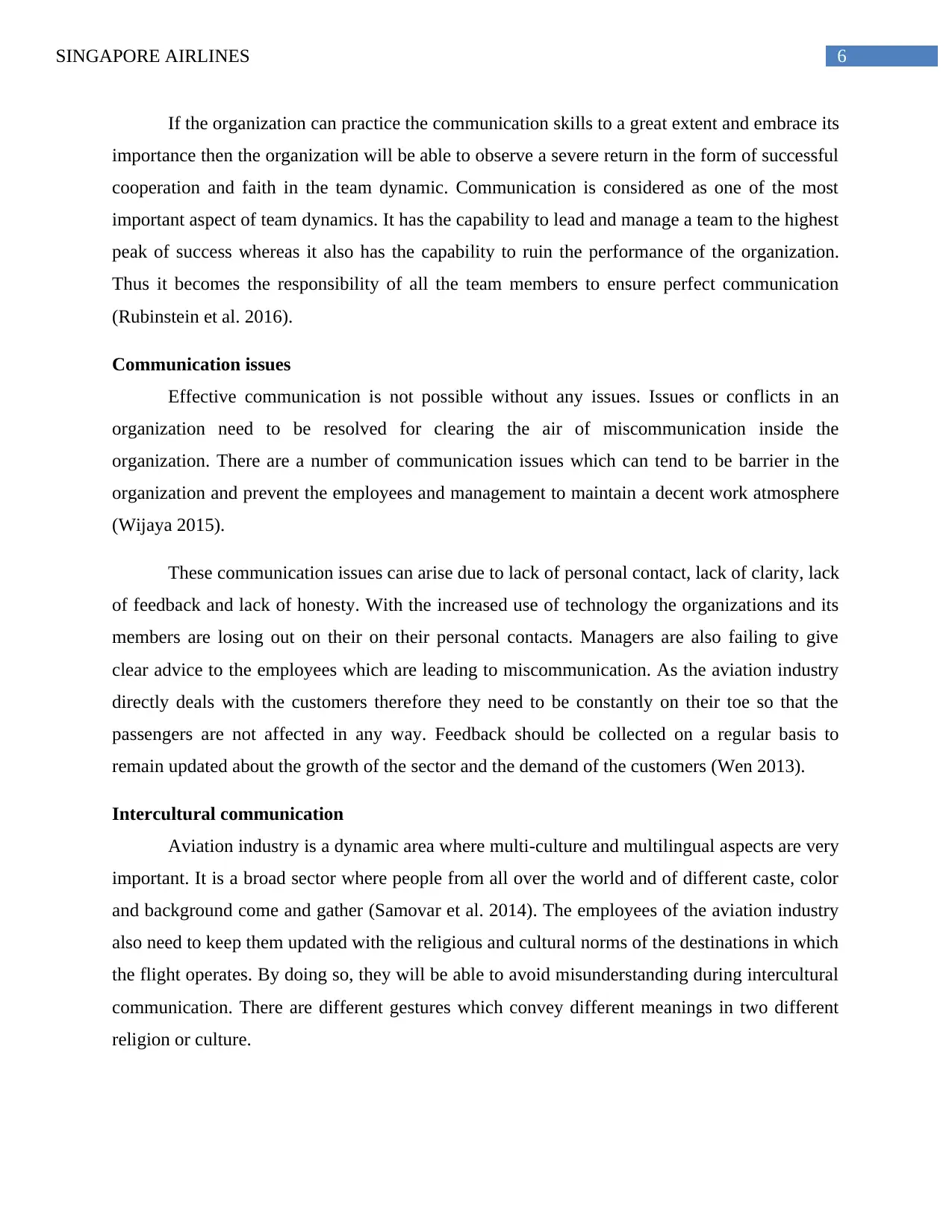
6SINGAPORE AIRLINES
If the organization can practice the communication skills to a great extent and embrace its
importance then the organization will be able to observe a severe return in the form of successful
cooperation and faith in the team dynamic. Communication is considered as one of the most
important aspect of team dynamics. It has the capability to lead and manage a team to the highest
peak of success whereas it also has the capability to ruin the performance of the organization.
Thus it becomes the responsibility of all the team members to ensure perfect communication
(Rubinstein et al. 2016).
Communication issues
Effective communication is not possible without any issues. Issues or conflicts in an
organization need to be resolved for clearing the air of miscommunication inside the
organization. There are a number of communication issues which can tend to be barrier in the
organization and prevent the employees and management to maintain a decent work atmosphere
(Wijaya 2015).
These communication issues can arise due to lack of personal contact, lack of clarity, lack
of feedback and lack of honesty. With the increased use of technology the organizations and its
members are losing out on their on their personal contacts. Managers are also failing to give
clear advice to the employees which are leading to miscommunication. As the aviation industry
directly deals with the customers therefore they need to be constantly on their toe so that the
passengers are not affected in any way. Feedback should be collected on a regular basis to
remain updated about the growth of the sector and the demand of the customers (Wen 2013).
Intercultural communication
Aviation industry is a dynamic area where multi-culture and multilingual aspects are very
important. It is a broad sector where people from all over the world and of different caste, color
and background come and gather (Samovar et al. 2014). The employees of the aviation industry
also need to keep them updated with the religious and cultural norms of the destinations in which
the flight operates. By doing so, they will be able to avoid misunderstanding during intercultural
communication. There are different gestures which convey different meanings in two different
religion or culture.
If the organization can practice the communication skills to a great extent and embrace its
importance then the organization will be able to observe a severe return in the form of successful
cooperation and faith in the team dynamic. Communication is considered as one of the most
important aspect of team dynamics. It has the capability to lead and manage a team to the highest
peak of success whereas it also has the capability to ruin the performance of the organization.
Thus it becomes the responsibility of all the team members to ensure perfect communication
(Rubinstein et al. 2016).
Communication issues
Effective communication is not possible without any issues. Issues or conflicts in an
organization need to be resolved for clearing the air of miscommunication inside the
organization. There are a number of communication issues which can tend to be barrier in the
organization and prevent the employees and management to maintain a decent work atmosphere
(Wijaya 2015).
These communication issues can arise due to lack of personal contact, lack of clarity, lack
of feedback and lack of honesty. With the increased use of technology the organizations and its
members are losing out on their on their personal contacts. Managers are also failing to give
clear advice to the employees which are leading to miscommunication. As the aviation industry
directly deals with the customers therefore they need to be constantly on their toe so that the
passengers are not affected in any way. Feedback should be collected on a regular basis to
remain updated about the growth of the sector and the demand of the customers (Wen 2013).
Intercultural communication
Aviation industry is a dynamic area where multi-culture and multilingual aspects are very
important. It is a broad sector where people from all over the world and of different caste, color
and background come and gather (Samovar et al. 2014). The employees of the aviation industry
also need to keep them updated with the religious and cultural norms of the destinations in which
the flight operates. By doing so, they will be able to avoid misunderstanding during intercultural
communication. There are different gestures which convey different meanings in two different
religion or culture.
Paraphrase This Document
Need a fresh take? Get an instant paraphrase of this document with our AI Paraphraser
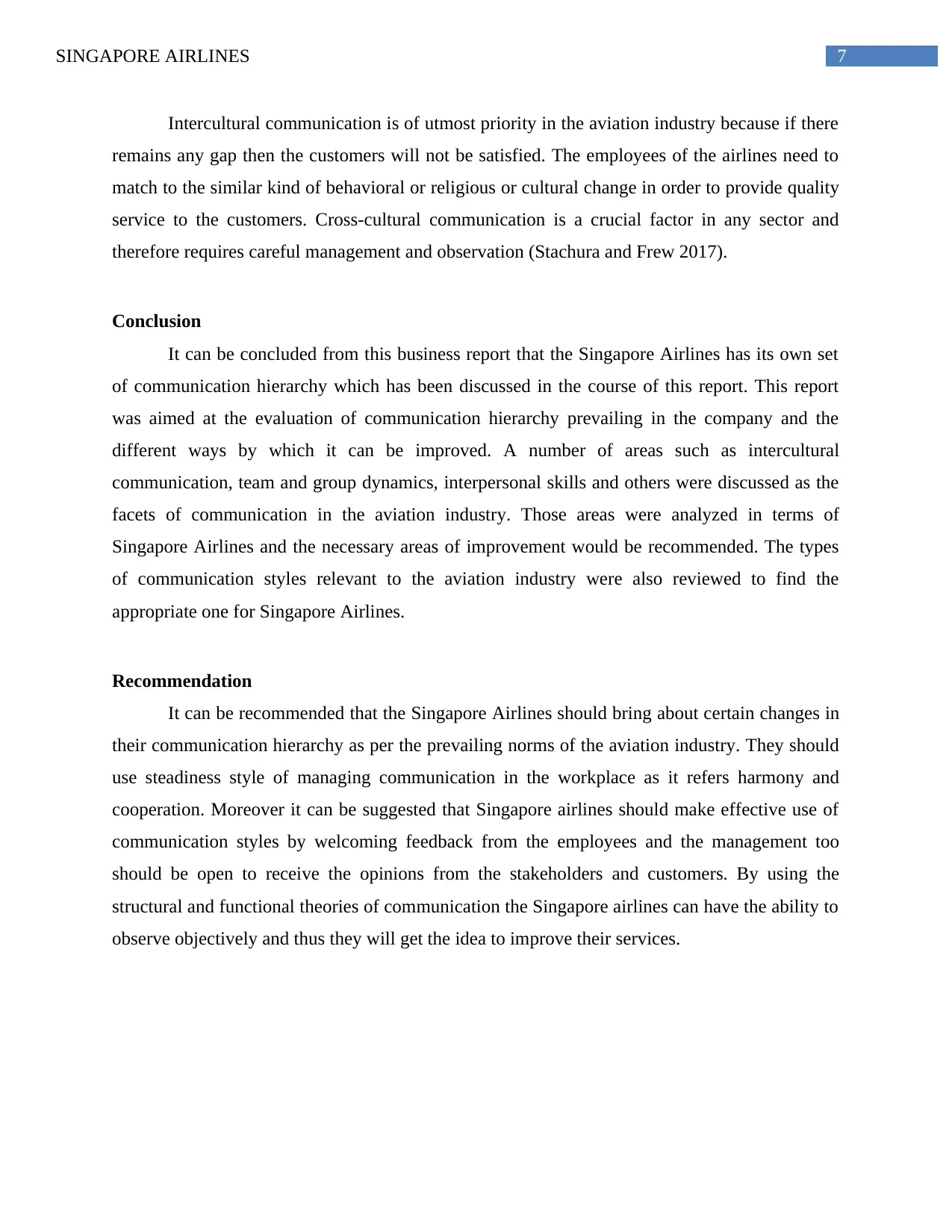
7SINGAPORE AIRLINES
Intercultural communication is of utmost priority in the aviation industry because if there
remains any gap then the customers will not be satisfied. The employees of the airlines need to
match to the similar kind of behavioral or religious or cultural change in order to provide quality
service to the customers. Cross-cultural communication is a crucial factor in any sector and
therefore requires careful management and observation (Stachura and Frew 2017).
Conclusion
It can be concluded from this business report that the Singapore Airlines has its own set
of communication hierarchy which has been discussed in the course of this report. This report
was aimed at the evaluation of communication hierarchy prevailing in the company and the
different ways by which it can be improved. A number of areas such as intercultural
communication, team and group dynamics, interpersonal skills and others were discussed as the
facets of communication in the aviation industry. Those areas were analyzed in terms of
Singapore Airlines and the necessary areas of improvement would be recommended. The types
of communication styles relevant to the aviation industry were also reviewed to find the
appropriate one for Singapore Airlines.
Recommendation
It can be recommended that the Singapore Airlines should bring about certain changes in
their communication hierarchy as per the prevailing norms of the aviation industry. They should
use steadiness style of managing communication in the workplace as it refers harmony and
cooperation. Moreover it can be suggested that Singapore airlines should make effective use of
communication styles by welcoming feedback from the employees and the management too
should be open to receive the opinions from the stakeholders and customers. By using the
structural and functional theories of communication the Singapore airlines can have the ability to
observe objectively and thus they will get the idea to improve their services.
Intercultural communication is of utmost priority in the aviation industry because if there
remains any gap then the customers will not be satisfied. The employees of the airlines need to
match to the similar kind of behavioral or religious or cultural change in order to provide quality
service to the customers. Cross-cultural communication is a crucial factor in any sector and
therefore requires careful management and observation (Stachura and Frew 2017).
Conclusion
It can be concluded from this business report that the Singapore Airlines has its own set
of communication hierarchy which has been discussed in the course of this report. This report
was aimed at the evaluation of communication hierarchy prevailing in the company and the
different ways by which it can be improved. A number of areas such as intercultural
communication, team and group dynamics, interpersonal skills and others were discussed as the
facets of communication in the aviation industry. Those areas were analyzed in terms of
Singapore Airlines and the necessary areas of improvement would be recommended. The types
of communication styles relevant to the aviation industry were also reviewed to find the
appropriate one for Singapore Airlines.
Recommendation
It can be recommended that the Singapore Airlines should bring about certain changes in
their communication hierarchy as per the prevailing norms of the aviation industry. They should
use steadiness style of managing communication in the workplace as it refers harmony and
cooperation. Moreover it can be suggested that Singapore airlines should make effective use of
communication styles by welcoming feedback from the employees and the management too
should be open to receive the opinions from the stakeholders and customers. By using the
structural and functional theories of communication the Singapore airlines can have the ability to
observe objectively and thus they will get the idea to improve their services.
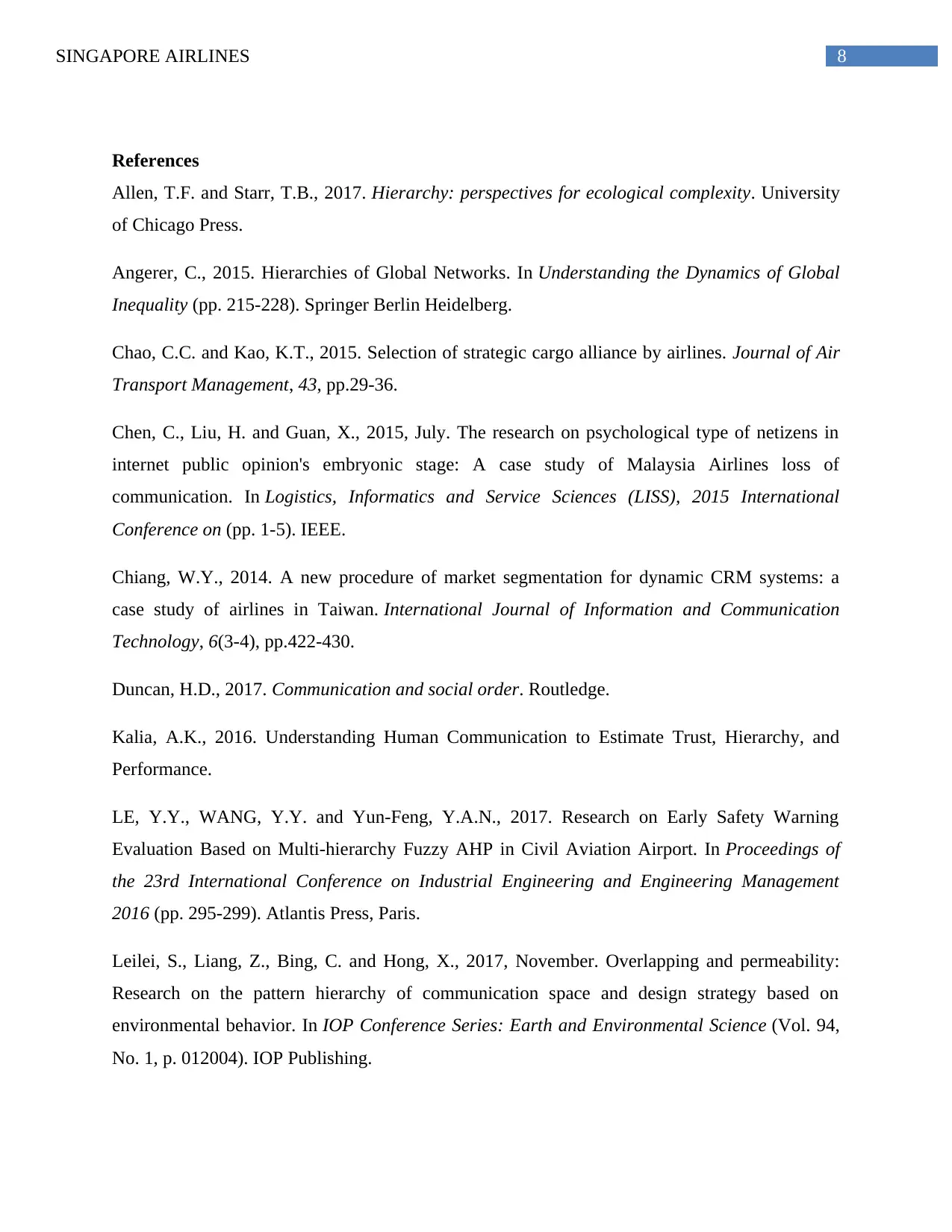
8SINGAPORE AIRLINES
References
Allen, T.F. and Starr, T.B., 2017. Hierarchy: perspectives for ecological complexity. University
of Chicago Press.
Angerer, C., 2015. Hierarchies of Global Networks. In Understanding the Dynamics of Global
Inequality (pp. 215-228). Springer Berlin Heidelberg.
Chao, C.C. and Kao, K.T., 2015. Selection of strategic cargo alliance by airlines. Journal of Air
Transport Management, 43, pp.29-36.
Chen, C., Liu, H. and Guan, X., 2015, July. The research on psychological type of netizens in
internet public opinion's embryonic stage: A case study of Malaysia Airlines loss of
communication. In Logistics, Informatics and Service Sciences (LISS), 2015 International
Conference on (pp. 1-5). IEEE.
Chiang, W.Y., 2014. A new procedure of market segmentation for dynamic CRM systems: a
case study of airlines in Taiwan. International Journal of Information and Communication
Technology, 6(3-4), pp.422-430.
Duncan, H.D., 2017. Communication and social order. Routledge.
Kalia, A.K., 2016. Understanding Human Communication to Estimate Trust, Hierarchy, and
Performance.
LE, Y.Y., WANG, Y.Y. and Yun-Feng, Y.A.N., 2017. Research on Early Safety Warning
Evaluation Based on Multi-hierarchy Fuzzy AHP in Civil Aviation Airport. In Proceedings of
the 23rd International Conference on Industrial Engineering and Engineering Management
2016 (pp. 295-299). Atlantis Press, Paris.
Leilei, S., Liang, Z., Bing, C. and Hong, X., 2017, November. Overlapping and permeability:
Research on the pattern hierarchy of communication space and design strategy based on
environmental behavior. In IOP Conference Series: Earth and Environmental Science (Vol. 94,
No. 1, p. 012004). IOP Publishing.
References
Allen, T.F. and Starr, T.B., 2017. Hierarchy: perspectives for ecological complexity. University
of Chicago Press.
Angerer, C., 2015. Hierarchies of Global Networks. In Understanding the Dynamics of Global
Inequality (pp. 215-228). Springer Berlin Heidelberg.
Chao, C.C. and Kao, K.T., 2015. Selection of strategic cargo alliance by airlines. Journal of Air
Transport Management, 43, pp.29-36.
Chen, C., Liu, H. and Guan, X., 2015, July. The research on psychological type of netizens in
internet public opinion's embryonic stage: A case study of Malaysia Airlines loss of
communication. In Logistics, Informatics and Service Sciences (LISS), 2015 International
Conference on (pp. 1-5). IEEE.
Chiang, W.Y., 2014. A new procedure of market segmentation for dynamic CRM systems: a
case study of airlines in Taiwan. International Journal of Information and Communication
Technology, 6(3-4), pp.422-430.
Duncan, H.D., 2017. Communication and social order. Routledge.
Kalia, A.K., 2016. Understanding Human Communication to Estimate Trust, Hierarchy, and
Performance.
LE, Y.Y., WANG, Y.Y. and Yun-Feng, Y.A.N., 2017. Research on Early Safety Warning
Evaluation Based on Multi-hierarchy Fuzzy AHP in Civil Aviation Airport. In Proceedings of
the 23rd International Conference on Industrial Engineering and Engineering Management
2016 (pp. 295-299). Atlantis Press, Paris.
Leilei, S., Liang, Z., Bing, C. and Hong, X., 2017, November. Overlapping and permeability:
Research on the pattern hierarchy of communication space and design strategy based on
environmental behavior. In IOP Conference Series: Earth and Environmental Science (Vol. 94,
No. 1, p. 012004). IOP Publishing.
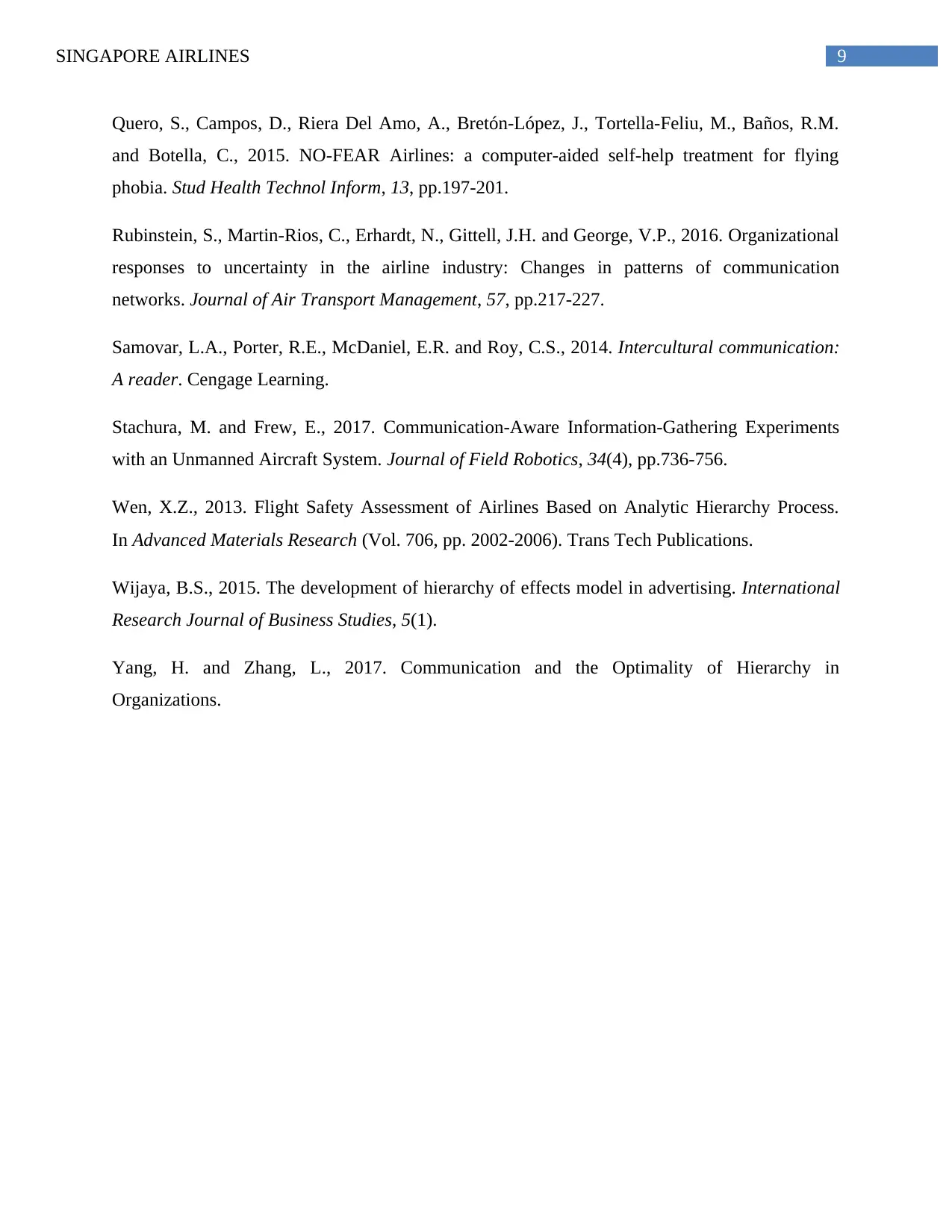
9SINGAPORE AIRLINES
Quero, S., Campos, D., Riera Del Amo, A., Bretón-López, J., Tortella-Feliu, M., Baños, R.M.
and Botella, C., 2015. NO-FEAR Airlines: a computer-aided self-help treatment for flying
phobia. Stud Health Technol Inform, 13, pp.197-201.
Rubinstein, S., Martin-Rios, C., Erhardt, N., Gittell, J.H. and George, V.P., 2016. Organizational
responses to uncertainty in the airline industry: Changes in patterns of communication
networks. Journal of Air Transport Management, 57, pp.217-227.
Samovar, L.A., Porter, R.E., McDaniel, E.R. and Roy, C.S., 2014. Intercultural communication:
A reader. Cengage Learning.
Stachura, M. and Frew, E., 2017. Communication‐Aware Information‐Gathering Experiments
with an Unmanned Aircraft System. Journal of Field Robotics, 34(4), pp.736-756.
Wen, X.Z., 2013. Flight Safety Assessment of Airlines Based on Analytic Hierarchy Process.
In Advanced Materials Research (Vol. 706, pp. 2002-2006). Trans Tech Publications.
Wijaya, B.S., 2015. The development of hierarchy of effects model in advertising. International
Research Journal of Business Studies, 5(1).
Yang, H. and Zhang, L., 2017. Communication and the Optimality of Hierarchy in
Organizations.
Quero, S., Campos, D., Riera Del Amo, A., Bretón-López, J., Tortella-Feliu, M., Baños, R.M.
and Botella, C., 2015. NO-FEAR Airlines: a computer-aided self-help treatment for flying
phobia. Stud Health Technol Inform, 13, pp.197-201.
Rubinstein, S., Martin-Rios, C., Erhardt, N., Gittell, J.H. and George, V.P., 2016. Organizational
responses to uncertainty in the airline industry: Changes in patterns of communication
networks. Journal of Air Transport Management, 57, pp.217-227.
Samovar, L.A., Porter, R.E., McDaniel, E.R. and Roy, C.S., 2014. Intercultural communication:
A reader. Cengage Learning.
Stachura, M. and Frew, E., 2017. Communication‐Aware Information‐Gathering Experiments
with an Unmanned Aircraft System. Journal of Field Robotics, 34(4), pp.736-756.
Wen, X.Z., 2013. Flight Safety Assessment of Airlines Based on Analytic Hierarchy Process.
In Advanced Materials Research (Vol. 706, pp. 2002-2006). Trans Tech Publications.
Wijaya, B.S., 2015. The development of hierarchy of effects model in advertising. International
Research Journal of Business Studies, 5(1).
Yang, H. and Zhang, L., 2017. Communication and the Optimality of Hierarchy in
Organizations.
1 out of 10
Related Documents
Your All-in-One AI-Powered Toolkit for Academic Success.
+13062052269
info@desklib.com
Available 24*7 on WhatsApp / Email
![[object Object]](/_next/static/media/star-bottom.7253800d.svg)
Unlock your academic potential
© 2024 | Zucol Services PVT LTD | All rights reserved.





